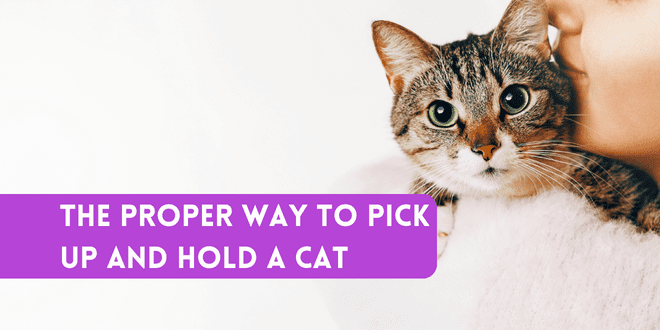
If some cats had their choice, many would prefer to never be picked up and held. For a cat, there’s tremendous security in having all paws on the ground and the ability to move at will.
For many cats, being picked up and lifted off the ground creates stress. If the cat is fearful or not used to being picked up, it can potentially create a situation in which someone may get scratched or bitten. A cat struggling to scramble out of a person’s grasp can also cause injury if kitty falls to the ground.
Know Your Cat’s Tolerance Level
Be sensitive to your cat’s tolerance levels and always have a purpose for picking him up. If your cat loves being held, then enjoy that closeness, but if he doesn’t, be respectful of the fact that lifting him up changes the level of security.
Don’t insist of holding a struggling cat with the intention of getting him to surrender or adjust. The longer you hold a squirmy, unhappy cat, the more he’ll hate being held the next time.
If your cat hates being picked up and held, slow down and just focus on being able to put one hand on his side and then releasing. Work up to placing a hand on each side and then letting go. When the cat is comfortable with that you can then use very gentle pressure when you place your hands on his sides and then let go and praise and reward your cat. Do this several times before you attempt to pick the cat up. Make sure the cat is comfortable with being touched.
Your Approach Shouldn’t Startle or Appear Threatening
Don’t grab your unsuspecting cat from behind in order to pick him up. No one likes being startled. Your cat should be aware of your presence but approach in a non-threatening way. Don’t make a direct approach from the front as that might cause some cats to feel threatened. If the only way you’re able to pick up your cat is to sneak up behind him and grab quickly then maybe it’s time to do some gentle training.
The Proper Technique for Holding a Cat
Some cats have very definite preferences when it comes to how they like to be held but your most important job is to provide security for both of you. The cat must feel secure in your arms and you must ensure you keep the kitty safe. No one must get injured in this process whether feline or human.
Specific handling techniques vary depending upon your cat’s comfort level and the particular environment (carrying a cat in a shelter, veterinary clinic, or outdoors involves more concern with preventing escape). In general, you must always use both hands when picking up a cat. Even though the cat may be small enough that you could scoop him up with one hand, it’s not secure and it certainly won’t be comfortable for the cat. Have you seen someone holding a cat by one hand where the poor kitty’s legs are left dangling? Not comfortable or at all secure. Always hold a cat, no matter how small, with both hands. Use one hand to cradle and support his back end. To secure the front end, it will depend on your cat’s preference and whether you’re in a safe environment or one where escape could prove dangerous. Most cats want to be supported under the chest so they can rest their front paws on your arm. This is the typical way many cat parents carry their cats in safe environments. If the cat is in an environment where escape would be dangerous, hold the front end by securing the front legs with the fingers of one hand while the other hand cradles the back end and holds the hind legs. If in an environment where escaping from your arms could be dangerous then the best method of transport is to have the cat securely in a carrier.
The first few training sessions shouldn’t involve any walking around – just let your cat get comfortable with being held and then placed back down. Hold the cat close to your chest so he doesn’t feel suspended in mid-air. Hold securely but don’t grip so tightly your cat feels uncomfortable. What matters most when holding a cat is that you need to make sure you have him securely and safely held and that he feels comfortable.
Don’t Cradle Your Cat on His Back
You love your cat like a member of the family but may even call kitty your baby but that doesn’t mean he wants to be held like one. There are some cats who don’t mind being carried that way but most don’t like being placed on their backs and held. It’s also a somewhat dangerous position because all claws will be pointed toward your face. That’s not a good position to be in if your cat gets scared or upset while being held.
Placing Your Cat Back Down
Don’t let your cat leap for your arms and don’t just drop him when you’re done holding. Gently place your cat back on the floor, cat tree, or another surface and give him time to get his footing. If you want the cat to enjoy or even just accept being held, the training process also includes a gentle and safe release.
If you’re training your cat to accept being picked up, keep the sessions short, positive and calm. Always place the cat back down before he shows any sign of struggling.
Don’t Pick Up Your Cat by Scruffing
Scruffing is something the mother cat does when she needs to move her very young kittens. Scruffing and one-handed holding are both uncomfortable and cause the bulk of the cat’s weight to just dangle in the air. Scruffing with one hand while gripping the cat by the hind legs with the other hand is basically putting kitty in a death grip. While this method will allow you to pick up your cat, it also isn’t doing anything to encourage him to ever want to be picked up and held again.
Never Hold Your Cat to Force Social Interaction
Yes, your cat is incredibly cute and you’d love for guests to see that adorable face up close, but don’t ever pick kitty up to force social interaction with people or other pets. It’s very stressful for the cat to be restrained in your arms at the same time being face to face with a stranger or unfamiliar animal. Whenever you pick up your cat it should have a purpose that’s beneficial, loving (meaning he should be the one who loves it) or necessary.
Picking Up Your Cat to be Placed in a Carrier
Picking up your cat to shove him in a carrier isn’t a fun experience for anyone and can result in lots of hissing and growling on his part and injury on your part. Take the time to train your cat to be comfortable with going into the carrier so you can gently place him in there without a struggle or least with minimal amount of stress.
Don’t Pick Up a Cat Who is Upset
When a cat is unhappy or angry isn’t the best time to try to pick him up. You may want to hold and cuddle your upset cat to comfort but that typically ends with kitty struggling to get out of your grasp. In these situations, what the cat needs most is some personal space and to be left alone. If you absolutely must pick up an angry cat, use thick towels to cover him first.
Teach Your Children the Proper Technique
Most cats don’t enjoy being held by children because they are either squeezed, dangled, or suddenly dropped. They may also be chased down in order to be held. If your children are too young to be taught the proper technique then work on instructing them how to sit next to cat and enjoy petting or how to invite the cat onto their laps. It may even have to start with the cat being on your lap while a child sits nearby. Go slowly and keep things positive and calm. Reward your cat for even the smallest amount of progress. This time of trust-building and security will pay off as you watch your cat become more comfortable with physical touch. Remember, the cat must always have the choice to move away.
Need More Information?
For more information on cat behavior and training, refer to the books by best-selling author and cat expert Pam Johnson-Bennett. Pam’s books are available at bookstores and online. We’ve included links to Amazon here on our website.
If you have a question about your cat’s behavior or health, contact your veterinarian. This article is not intended as a medical diagnosis nor is it a replacement for your cat’s regular veterinary care. This article is for general information purposes only.




